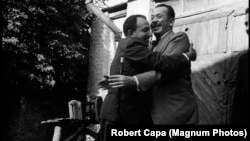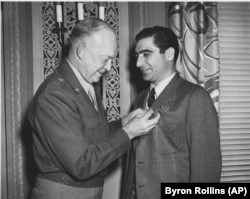Seventy years ago, as the Cold War was dawning between former World War II allies the United States and the Soviet Union, one of America's most prominent writers, John Steinbeck, and one of the world's most celebrated combat photojournalists, Robert Capa, published A Russian Journal. It was a slim volume billed as "honest reporting, to set down what we saw and heard without editorial comment, without drawing conclusions about things we didn't know sufficiently."
Steinbeck's book, illustrated with Capa's dramatic photographs, was an effort to explore "the great other side."
"It is not the Russian story," the book states, "but simply a Russian story."
The 1948 book was based on a 40-day tour of the Soviet Union that the two men undertook the previous summer, just a year after Winston Churchill's famous declaration that "from Stettin in the Baltic to Trieste in the Adriatic an 'iron curtain' has descended across the continent [of Europe]."
During the trip, they visited Moscow, Leningrad (now St. Petersburg), Stalingrad (now Volgograd), and Georgia. They also spent nine days in Soviet Ukraine, visiting Kyiv and some nearby collective farms.
Current Time TV, the Russian-language network run by RFE/RL in cooperation with VOA, has gained access to a seven-page report filed by the Soviet secret police covering the Ukrainian portion of this historic journey. The document -- titled A Special Report On The Visit To Ukraine Of American Writer Steinbeck and dated August 31, 1947 -- was recently declassified by the former KGB archive in Kyiv.
Similar documents covering other parts of the two men's journey likely remain classified in Russian archives.
"During their stay in Kyiv, Steinbeck and Capa were accompanied by agents daily, were constantly monitored, and ____," the document says. It was standard practice by Soviet security officers to leave such blanks in their reports and to fill them in later by hand in order to prevent typists from getting access to sensitive information. This blank, however, was never filled in and must remain a mystery.
The Soviets generally had a positive view of Steinbeck. His classic novel The Grapes Of Wrath, depicting the suffering of American farm workers during the Great Depression, was published and widely read there as an example of the horrors of capitalism. By the time Steinbeck arrived in the Soviet Union, however, American farmers were doing much better and the writer praised the U.S. government for the assistance it provided to them.
Capa was born in Hungary in 1913 and became one of the world's most audacious and celebrated war correspondents. He covered the Spanish Civil War (where he captured one of the most enduring images of that conflict) and the Second Sino-Japanese War in the late 1930s. During World War II, he landed with U.S. forces at Omaha Beach on D-Day and took 11 of the most famous images of that historic operation. He was killed in 1954 at the age of 40 when he stepped on a land mine while covering the French war in Indochina.
It is clear from the 1947 Soviet report that the agents strongly suspected that Steinbeck and Capa were carrying out a mission for the U.S. government. They noted that one of the first things Steinbeck did upon arriving in Moscow was to meet with U.S. Ambassador to the Soviet Union Walter Bedell Smith.
According to the document, the Soviets believed "the ruling circles of the United States were using Steinbeck's stature as a writer and his political authority in the Soviet Union to carry out pro-American propaganda." The goal, they wrote, was to cast blame on the Soviet Union for the deteriorating international political climate.
The agents note that Steinbeck made public statements in favor of U.S. economic assistance to Europe and refused to express support for American communists or other pro-Soviet foreigners.
At an event hosted by Ukrainian playwright Oleksandr Korneichuk, head of the Ukrainian Union of Writers, Steinbeck participated in a toast in honor of Soviet dictator Josef Stalin but pointedly stated that he was drinking "also for the Soviet people."
According to other documents found in the former KGB archive in Kyiv, at least three of the Ukrainian writers present at the event, including Korneichuk, were informants.
In addition, Steinbeck was accused of "studying the political mood of the people and, apparently, the agricultural potential of the Soviet Union." The report notes that Steinbeck was the "fourth American" to come to the Soviet Union asking questions about agriculture and the harvest.
In the report, Steinbeck was described as "quiet" and "closed." It says he rarely asked questions and responded to questions "unwillingly." Capa was the opposite -- unusually talkative and curious. Nonetheless, the Soviets clearly viewed Steinbeck as the leader of the mission, and scant attention was paid to Capa's statements or actions.
The report claims that although Steinbeck did not ask any questions, he returned from visiting the collective farms with detailed knowledge of how many tractors, milking machines, and generators they had. The report also notes that Steinbeck traveled from Kyiv straight to Russia's agricultural Don region without expressing interest in visiting the industrial Donbas region in eastern Ukraine.
The Soviet agents suspected that the Hungarian-born Capa secretly spoke Russian. Steinbeck writes in the book that Capa did not, but says "in the course of a month he learned a few words that he pronounced with some sort of accent, apparently Uzbek."
Nonetheless, the Soviet report said Capa answered questions before his translator had time to translate them and reacted to jokes and other statements without waiting for translations. Capa frequently expressed sympathy for the Soviet Union, the report says.
The vast majority of the photographs Capa took for the project showed the Soviet Union in a positive light. According to the report, "several" of his negatives were confiscated by censors before Capa was allowed to leave the country, but it is unclear what became of them. The report also claims that some unknown documents with "suspicious content" were taken from Capa. Those documents, which were supposedly appended to the report, have likewise gone missing.
It is unknown whether Steinbeck was actually carrying out some sort of mission for the U.S. government during his 1947 trip. However, in 2013, academic Brian Kannard published a study called Steinbeck: Citizen Spy that revealed the writer's connections with the CIA.
Kannard managed to get a 1952 letter that Steinbeck sent to the CIA prior to a trip to Europe in which he informed the CIA director -- the same Walter Bedell Smith who had been the U.S. ambassador in Moscow in 1947 -- that he would "be pleased to be of service."
In another letter also released by the CIA, Smith responded with appreciation.
"You can, indeed, be of help to us by keeping your eyes and ears open on any political developments in the areas through which you travel," Smith wrote, proposing a meeting after Steinbeck's return to the United States.
In 1962, Steinbeck won the Nobel Prize in Literature. The following fall, he returned to the Soviet Union, again visiting Kyiv. No documents concerning this trip have yet been uncovered in the former KGB archive.











